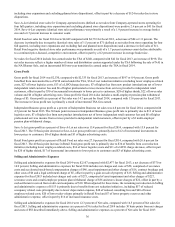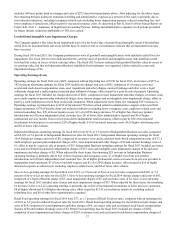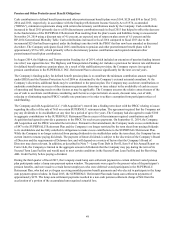Albertsons 2015 Annual Report Download - page 48
Download and view the complete annual report
Please find page 48 of the 2015 Albertsons annual report below. You can navigate through the pages in the report by either clicking on the pages listed below, or by using the keyword search tool below to find specific information within the annual report.
46
LIQUIDITY AND CAPITAL RESOURCES
Overview
Management expects that the Company will continue to replenish operating assets and pay down debt obligations with
internally generated funds. A significant reduction in operating earnings or the incurrence of operating losses could have a
negative impact on the Company’s operating cash flow, which may limit the Company’s ability to pay down its outstanding
indebtedness as planned. A substantial portion of the Company's total assets and certain subsidiary stock are secured under the
Company's credit facilities.
The Company’s primary sources of liquidity are from internally generated funds and from borrowing capacity under its credit
facilities. The Company will continue to obtain short-term or long-term financing from its credit facilities. Long-term financing
will be maintained through existing and new debt issuances and its credit facilities. The Company’s short-term and long-term
financing abilities are believed to be adequate as a supplement to internally generated cash flows to fund capital expenditures as
opportunities arise. There can be no assurance, however, that the Company’s business will continue to generate cash flow at
current levels or that it will continually have access to credit on acceptable terms. Maturities of debt issued will depend on
management’s views with respect to the relative attractiveness of interest rates at the time of issuance and other debt maturities.
Primary uses of cash include debt maturities and servicing, capital expenditures, working capital maintenance, contributions to
various retirement plans and income tax payments. The Company’s working capital needs are generally greater during the
months leading up to high sales periods, such as the time period from prior to Thanksgiving through December. The Company
typically finances these working capital needs with funds provided by operating activities and short-term borrowings.
Inventories are managed primarily through demand forecasting and replenishing depleted inventories. Strategic and operational
investments in the Company’s businesses and working capital needs are funded by cash provided from operations and on a
short-term basis through available liquidity.
The Company improved its capital structure through several actions during fiscal 2015, including the issuance of $350 of the
2022 Notes and redeeming $350 of the 2016 Notes and amending the Revolving ABL Credit Facility twice to lower interest
rates, extend the maturity and provide greater flexibility to refinance the balance of the 2016 Notes. In addition, the Company
entered into a forward starting interest rate swap agreement effectively converting $300 of variable rate debt to fixed rate debt
to reduce the Company's exposure to changes in market interest rates. The Company’s continued access to short-term and long-
term financing through credit markets depends on numerous factors including the condition of the credit markets and the
Company’s results of operations, cash flows, financial position and credit ratings.
Unused available credit under the Revolving ABL Credit Facility was $871 and $786 as of February 28, 2015 and February 22,
2014, respectively. In addition, the Revolving ABL Credit Facility, as amended, provides that the Company may incur
additional term loans under the Secured Term Loan Facility (as defined below) in an aggregate principal amount of up to $500,
subject to identifying term loan lenders or other institutional lenders willing to provide the additional loans and satisfying
certain terms and conditions.
Working capital was $378 and $254 excluding the LIFO reserve as of February 28, 2015 and February 22, 2014, respectively.
The increase in working capital when compared with February 28, 2015 is primarily due to increases in inventory, net of related
accounts payable, and cash.
As of February 28, 2015, aggregate debt maturities due in fiscal 2016 and fiscal 2017 were $10 and $293, respectively. Based
on the Company's excess cash flow calculation (as defined in the Secured Term Loan Facility) for the fiscal year ended
February 28, 2015, no prepayment will be required in fiscal 2016. The potential excess cash flow prepayment that would be
required in fiscal 2017 is not reasonably estimable as of February 28, 2015. The Company did not have an excess cash flow
prepayment in fiscal 2015 or 2014. Payments to reduce capital lease obligations are expected to approximate $26 in both fiscal
2016 and 2017.
Cash Flow Information
Operating Activities
Net cash provided by operating activities from continuing operations was $333, $129 and $427 in fiscal 2015, 2014 and 2013,
respectively.
The increase in net cash provided by operating activities from continuing operations in fiscal 2015 compared to last year is
primarily attributable to prior year cash uses following the NAI Banner Sale, including an increase in cash used in accounts
payable and accrued liabilities in the prior year due to $96 of employee-related payables primarily attributable to the fiscal
2014 workforce reduction and an increase in cash provided by receivables of $63 primarily due to shipping method changes,
























